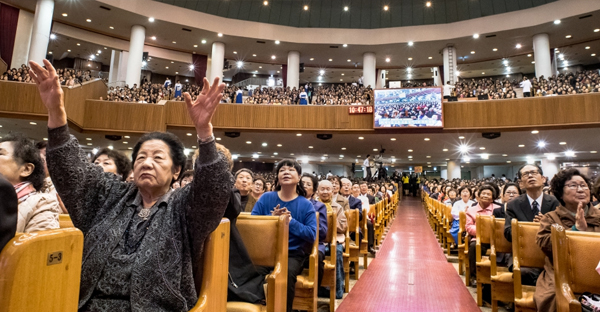[ad_1]

Yoido Full Gospel Church began in 1958 and grew by serving poor and working class South Koreans who moved to the capital city of Seoul. Today, it’s largest megachurch in the world. (Credit: Steve Smith)
If the building didn’t have a giant cross out front, it could easily be mistaken for a sports arena.
But this is Yoido Full Gospel Church, a Pentecostal congregation belonging to the Korean Assemblies of God — a household name in South Korea. The institution is also known as the largest megachurch in the world, with a congregation approaching 800,000 people, according to church officials.
Protestant megachurches, defined as those with at least 2,000 people in attendance every week, don’t just operate all across the United States. This is a global phenomenon.
Successful megachurches are operating in South America, Africa and Asia as well. And yet, no city has more of them than Seoul. The South Korean capital has 17 megachurches in all.
Still, Protestant evangelical leaders in South Korea are facing a new challenge. Their public image has taken a hit in recent years due to a series of scandals, and the era of boundless growth for their congregations appears to have come to an end.
Sunday services at Yoido Full Gospel Church start at 7 a.m. and run the whole day, until 7 p.m. They’re not in the same building at the same time, but officials say nearly 200,000 people attend worship services every week at the main church in Yeouido, an island in central Seoul that sits in the Han River.
Yeouido Island is also where the South Korean National Assembly building is located, along with several big media companies.
The scene inside the main sanctuary of the Full Gospel Church is impressive. There are seats for about 15,000 worshippers. Giant video screens carry simultaneous translations of parts of the service in Chinese, Japanese and English. Audio headsets are available with translations from the original Korean into numerous other languages. The choir has about 120 vocalists decked out in white robes and backed up by a full orchestra.

The message at Yoido Full Gospel Church is about faith, the Bible, and prosperity. The music is provided by a professional choir and a full orchestra. The message at Yoido Full Gospel Church is about faith, the Bible, and prosperity. The music is provided by a professional choir and a full orchestra. (Credit: Steve Smith)
Talking with members of the congregation on the main steps outside of the church, several people echo a sense of awe. They say they can feel the presence of the Holy Spirit at Full Gospel Church, and that’s what keeps them coming back.
At certain times during the service, people in the pews close their eyes, raise up their hands and even speak in tongues, creating a real revival atmosphere.
“When I was in my 20s, I went to another church. But it was kind of superficial,” says Lee Chong-sook, a 55-year-old attending Sunday morning service with her husband, their two young-adult children, and Lee’s sister-in-law.
“When I first walked past this church and I heard the preaching, I started to cry. It touched my soul. I felt joy and I felt healed from pain and sorrow,” Lee says.
The message from the pulpit would sound familiar to a lot of Christian evangelicals in the US. It’s about a strict interpretation of the Bible, with a focus on the power of prayer and positive thinking.
Pastor Yong-gi Cho, now retired, founded the Full Gospel Church in Seoul in 1958. It all started with simple worship services for just a few people at a time, gathered under a tent.
“So many poor people had no place to go, no job, no income. Then, I came,” Cho tells me.
“I began to give hope to them [through the Bible]. Religion is useless if religion can’t give hope,” Cho says. “People began to swarm to the tent church, the poor people, they needed to have hope.”
Cho’s congregation grew and grew through the 1960s, ’70s and ’80s, right along with the South Korean economy. He earned a reputation as a healer. Indeed, two people I spoke with at the church tell me they were healed from illnesses.
Cho also preached a Korean version of the prosperity gospel, which taught that leading a prayerful lifestyle will bring rewards not only in terms of health, but in wealth.
Click here to read more.
SOURCE: PRI
Matthew Bell
Related
[ad_2]
Source link
